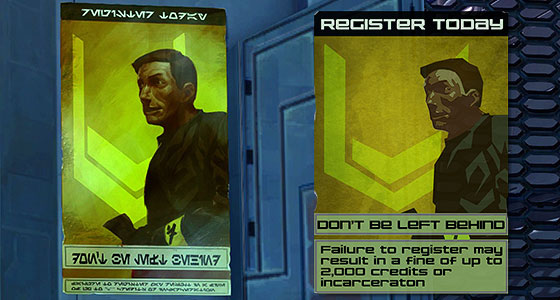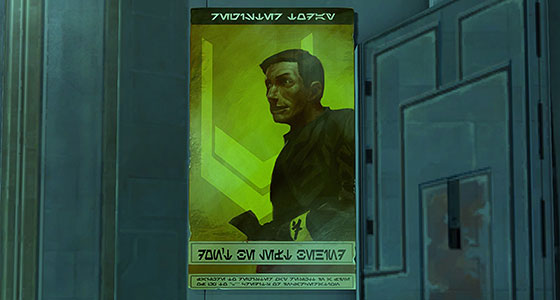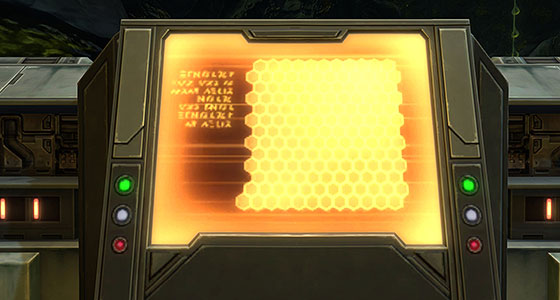One month after I launched This Week in Aurebesh, Trump won the presidential election and I considered scrapping this project in despair. I decided to keep going because I knew I would need a distraction in the days ahead, and I thought others out there could use one too. Over the next few years, this endeavor, SWTOR itself and the community of wonderful people I get to play with became an important respite from the turbulence of real life. But it can be hard to talk about fake space letters, giant robots and laser swords when so much is on the line. As an old straight white dude in a blue state, I have it lucky, but I fear for my friends and loved ones who just want to live their lives. People should be able to be who they are without fear. People should be able to love who they love without fear. Women should be able to decide what to do with their bodies without fear. People should be able to go to school, to church, to the store without fear.
Star Wars is a story about rebellion against institutions that seek to rule with fear, and its metaphors are not about a bygone age, but of every age, including our own. But it’s just a story, a simple children’s story even. The story of our age is much more complicated and difficult, but now more than ever, in my real life, I will continue to do what I can to stand up for the rights of people who are being forced into the margins, the shadows and the closet. This is the core value of my faith and the aspiration of my adopted country, and I think it is something worth fighting for.
As for this dumb little blog, I’ve got a half-written Obi-Wan Kenobi review and a folder filled with untranslated Aurebesh, and as the spirit moves me, I’ll endeavor to keep this corner of the internet a place for folks to find a small distraction from their day. I don’t know if it’ll work, but I will try.
Justicar Propaganda: Special Edition
I’d originally hoped to feature a new translation in this post, but as you’ll read in the next section, I had to give up on that effort. To get back on track I thought I’d take another crack at one of the first Aurebesh graphics I examined in 2016.

When I started this project, the goal was for my versions to simply be “quick and dirty” copies rather than the more faithful recreations I aim for now. I suppose my first attempt does have a certain rough charm, but I don’t think it’s aged well in comparison to my other efforts so a second pass felt in order.
The challenge of this new recreation was to match the painted texture of the background, the rough edges of the paper, and to more closely duplicate the original layout, things I only gestured at the first time around.
For example, I used lower case text in my first pass, and I’ve since come to the conclusion that Aurebesh (or at least my recreations of it!) work best in upper case. Technically Aurebesh does not include lower case letters at all, but various versions of the font over the years have attempted to fill the gaps in the original with features like case, punctuation and numbers. Some of these additions have stuck to various degrees, but when it comes to rules for upper and lower case, I don’t think any have been successful. I now prefer to always translate Aurebesh into upper case English letters.
While most of the elements of my recreation were made from scratch, I must confess the figure was digitally traced. The generic term for this process is “cheating”, so I guess a little bit of a “quick and dirty” ethos remains. As for the figure of the Justicar himself, I wonder if the symbol on the his sleeve is meant to have a specific meaning. It almost looks likes an Aurebesh “D” or maybe an inverted “S”, but it also somewhat recalls the “service bar” stripe with dashes and pips seen on the lower sleeve of Starfleet uniforms of the original Star Trek movies. All that said, the thing it most closely evokes is the armband worn on fascist uniforms in our own world, and that is, of course, right up the Justicar’s alley.
Atrisian or Not, Here I Come
Since this post has been mainly focused on my process, I thought it might be interesting to look at something in the game that I failed to translate. I’d originally hoped to recreate the monitor used in the terminal in the tunnels during the Rakghoul Resurgence event, but my efforts came to naught.
The font used on the left side of the display is most likely “Dark Katarn” or Atrisian, a typeface inspired by alien writing used in early Lucasarts games, particularly the classic Dark Forces. Like Aurebesh, these letters seems to have been based on those seen in Return of the Jedi. Unlike Aurebesh, however, the Lucasarts version was never codified into a full alphabet, and it remains a mostly obscure typeface. In SWTOR, it is most often seen as the alphabet used on Rakata ruins across Belsavis and the Foundry Space Station. I think it is a clever way to suggest an ancient language similar to, but still different from the more familiar Aurebesh.
As for this display, while I do think it is probably Atrisian, I do see letters here that could be from other fonts like Aurebesh, Huttese and Sith Prophecy. The text is so low resolution that I don’t feel confident making any kind of definitive statement about what we’re seeing here. Does it actually mean anything? Maybe? Probably not? I just can’t say for sure.
And that’s okay. I’ve often said that it’s not necessary for every alien language in Star Wars to be translatable. Fake space letters are meant evoke a fantastic setting without constraining creators to a rigid set of rules that they might break when aiming to simply make something look neat. And this does look neat and not at all out of place in the Star Wars setting whether it has an English meaning or not.
The image linked above shows a closer look at the display as it appears in game with the Bloom setting both on and off. Feel free to take a closer look yourself, and if you can suss out a meaning I’ve missed, please let me know!


